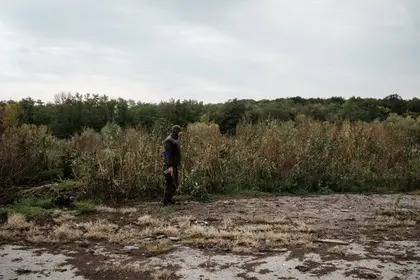Predictions and expectations of when the promised Ukrainian “spring counteroffensive” would start filled the pages of the international media from the start of the year with noticeably increasing irritation as to why, as summer approached, it still hadn’t got off the ground.
By the end of May, President Zelensky had to defend himself against allies who, having shipped billions of dollars’ worth of weapons systems and ammunition to help the war effort, urged him to get on with it. He argued that the weather, the need to properly train his troops and the fact that Ukraine’s armed forces still lacked enough Western weapons to succeed without suffering too many casualties was holding things up.
The time taken for Ukrainian forces to get themselves ready to go on the offensive gave the Russians the time to develop and prepare its defensive positions which seemed to grow exponentially with every passing day. The diagram below shows, in simplistic terms, the lay-out for one line of defense. In some areas these are repeated two or three times to provide three or four layered barriers representing several kilometers of in-depth defense.

Cross-section of typical Russian defensive position
All of these defenses are laid out in a zig-zag pattern which enables mutual fire support between trenches and ensures obstacles such as the minefields, the lines of dragon’s teeth (concrete pyramids designed to hold up armored vehicles) and the anti-tank ditches are covered by both direct and indirect fire weapons.

‘Smoke Screens Protect Troops’ as Ukrainian Tanks Strike Russian Forces and Evade FPV Drones in Kurakhove
The utility of minefields
One of the most comprehensive descriptions of both the use of and countering minefields on the battlefield is contained in the US Marines Field Manual (FM) 20-32 C4, entitled “Mine/Countermine Operations” viewed by many western forces as the “landmines bible.”
In its 517 pages, the document covers the subject in great detail and includes: technical information on US, allies and potential enemies’ landmines; the tactical purpose of minefields; manual and mechanical methods for laying mines; the physical and psychological impact of mines on troops; techniques for identifying the location and layout of minefields; and finally, the conduct of breaching and clearing operations.
The manual identifies four different types of minefield, each of which has a clear battlefield purpose in support of the overall operational plan or concept:
• Protective minefields - employed to protect locations, soldiers, equipment, supplies, and facilities from enemy attack;
· Tactical minefields – designed to influence an enemy's ability to maneuver and direct it into an area chosen by the defender to maximize his advantages;
· Nuisance minefields – intended to cause the enemy confusion by disrupting, delaying, weakening or destroying attacking and reserve forces;
· Phony minefields – by either camouflaging the location of real minefields, causing the enemy to be fearful of mines or waste time and resources dealing with them. This can be especially valuable if the enemy is already “mine-sensitive.”
The tactical key to the use of mines is to lay them in known areas, in known patterns and with known safe routes and record them on minefield maps, so that the defender is able to exploit that knowledge should it need to counter-attack. It is normal to fence minefields (real or imaginary) to enable them to be swiftly identified.
It is also part of military doctrine to ensure that the minefields, the gaps between them and the areas into which you wish to funnel the enemy are covered by direct and indirect fire.
Russia’s minefields in Ukraine
Russia initially followed the classic doctrine as outlined above as part of its defensive plan but as time has gone on its troops seem to have simply laid more and more mines, both conventionally and delivered remotely.
The end result is what could be called “barrier minefields”, extending for kilometers in length and sometimes as much as 5 or more kilometers deep.
This is presenting a definite problem for Ukrainian attacking forces which currently have limited mine breaching capabilities and what they do have is being destroyed as getting through the mines’ barrier is so slow.
During an interview with a Ukrainian Leopard tank crew by the German news channel “Welt nachtrichtensend,” the journalist asked why they didn’t just drive around the minefield. The Ukrainian officer commented that during their training in Germany, instructors plotted minefields 100 by 200 meters in size on their maps, "and we have hectares of these minefields, do you understand?".
The downside for Russian forces, should they wish to counter-attack the Ukrainian counteroffensive, is it too will have to negotiate the mines barrier. It looks like they have been so enthusiastic in laying their own mines they are unlikely to have minefield maps to guide them through and will face much the same problem as Kyiv’s forces.
They must be aware of this, which leads commentators to think that their sole mission is just to “hold the line” for as long as possible in the hope Ukraine runs out of momentum, men or equipment.
As President Zelensky said in his July 14 nightly address: “We must all understand very clearly, as clearly as possible, that the Russian forces on our southern and eastern lands are investing everything they can to stop our warriors, and every thousand meters of advance, every success of each of our combat brigades deserves gratitude.”
Minefield countermeasures - breaching
The marine field manual defines a number of landmine clearing scenarios such as route clearance, obstacle reduction, area clearance and others. For the purposes of this article and Ukraine’s operational needs we will only consider the need for “BREACHING.”
Breaching is the use of what the US marines call tactics, techniques, and procedures (TTP) to enable the attacker to get through the minefield as quickly as possible so that it can deploy its forces and seize the initiative on the far side of the obstacle.
FM 20-32 C4 goes into great detail on the need and methods to acquire intelligence about the kind of minefield, location, types of mine, depth of minefield etc. the enemy is using. In some ways the Ukrainian problem is easier since they know there are a huge number of mines, in deep layers, probably with no discernible pattern and that they are in front of the enemy positions.
The issue is how to get through them quickly enough and with sufficient strength to engage and overcome the enemy defensive positions.
Like all military operations there are measures that should be taken to increase the likelihood that the breaching procedure will succeed. In theory breaching can be done covertly as well as overtly or, if you prefer, noisy or quiet.
Covert breaching relies on the use of manual clearance methods, probably under cover of darkness. This is basically men, on their stomachs using mine detectors or prodders to clear routes through the minefield for attacking forces subsequently to exploit.
It is highly unlikely that this would be an appropriate methodology here, the minefields are too deeply laid and the current available hours of darkness would be insufficient to give time to get through. It would be theoretically possible to carry out the breach over a number of nights but there is always the danger of detection of the clearance done by enemy observation during the day.
The only practical approach for Ukraine would be an overt “noisy” breach. To do so there are four main principles to be considered.
· Securing the start line – the attacking force must be sure that their actions are not going to be interfered with at the start, during and on completion of the breach. The security of the latter is particularly important as follow-up forces move through the breach, the enemy must be prevented from using the cleared lanes to counter-attack.
· Suppression – on the assumption that the minefields will be covered by both direct and indirect fire it is essential that when the breaching assault begins, the maximum amount of firepower is brought down on the enemy for as long as necessary to protect the attacking force and to achieve the breakthrough;
· Obscuration – where possible the ability of the enemy to see what’s going on and acquire targets can be minimized by deploying obscuring smoke onto the enemy positions, the space between them and the minefield, making sure the breaching troops are not being similarly affected;
· Minimum clearance – the breach must be made as quickly as possible and clear sufficient lanes for the attacking force to get through and accomplish the mission, while avoiding wasting time to create redundant lanes.
Minefield breaching equipment
Ukrainian forces have learned the hard way that breaking through these mined areas is impossible using conventional breaching methods.
Ukraine’s Commander in Chief, General Valery Zaluzhny, has said: “You can no longer do anything with just a tank with some armor, because the minefield is too deep, and sooner or later, it will stop and then it will be destroyed by concentrated fire.”
Ukraine’s Western allies have provided some mine breaching equipment but not on the scale that is needed to overcome the size of the barrier that exists.
Ukrainian officials are quoted as saying that Kyiv has received much less demining and engineering materiel that they have requested as more offensive weaponry has been the priority.
A review of equipment provision on web-sites such as “Oryx” indicate that a total of less than 30 mine clearing vehicles have been provided of which less than half would be suitable for breaching under fire.
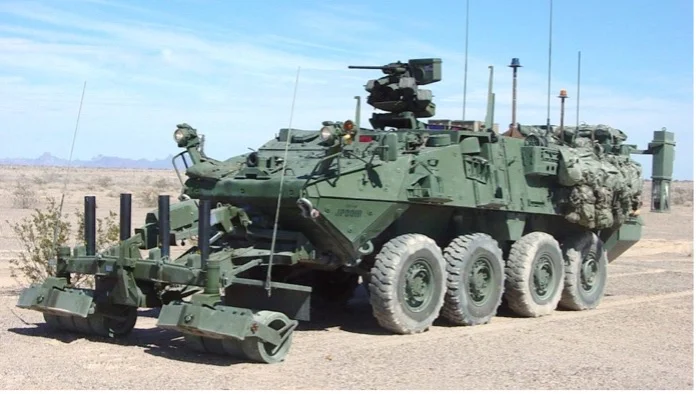 Stryker Combat Engineer vehicle.Photo:Wikimedia
Stryker Combat Engineer vehicle.Photo:Wikimedia
The equipment provided includes:
Engineering equipment
Purpose-built mine clearance vehicles such as the combat engineering version of the Stryker armored vehicle provided by the US, or the Finnish-provided Leopard 2R mine-clearing tank, are vulnerable to enemy fire as they have only light or medium machine guns for self-protection.
Canada provided GCS-200 mine clearing vehicles produced by the Swiss company Global Clearance Solutions (GCS), which is an unmanned, remote-controlled piece of equipment suitable for humanitarian demining but not for military action.
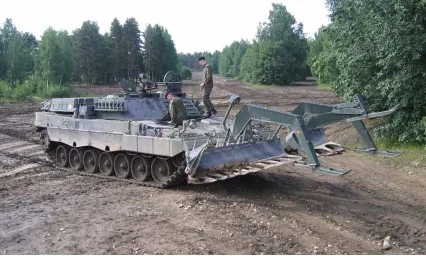
Leopard 2R mine-clearing tank.Photo:Wikimedia
Mine plows
Another option which has been provided to Ukraine by the US, the UK and Germany are full-width mine plows which can be attached to an armored vehicle, such as a main battle tank.
This allows it to make its own breaching lane by pushing mines aside while defending itself using its main armament. While these would be ideal tools for this purpose, insufficient numbers have been provided to achieve the necessary breakthrough.
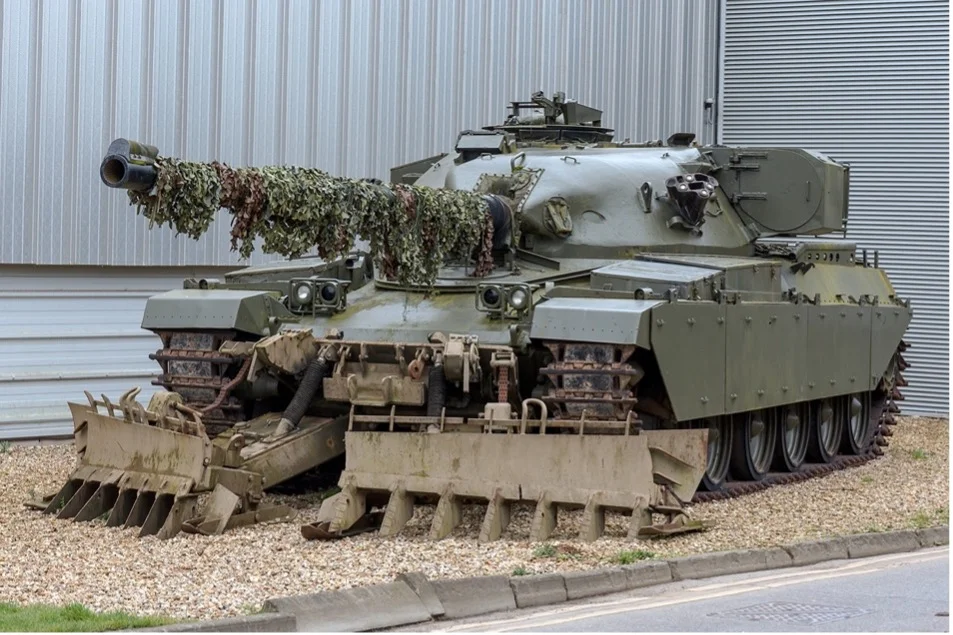
Example of a full-width mine plow (on Chieftain MBT).Photo: Bovington armored museum
Mine clearing line charge (MICLIC) systems
The US provided a number of the M58 MICLIC systems, which are rocket-projected mine-clearing “explosive hoses,” at the end of 2022. While it is rapidly deployable it only clears a lane some 100 meters long so is not really adequate for supporting breaches of the kilometer-wide minefields in front of the majority of Russian defensive positions.
Cluster munitions
It was recently announced that the US was to provide Ukraine with 155 mm dual-purpose improved conventional munition (DPICM) cluster munitions, in what is anticipated to be relatively large numbers.
While not designed as a mine clearing weapon or listed in any current doctrine I believe that, with a little bit of lateral thinking they could be employed as a breaching tool on the same principle as the MICLIC – destroying the mines by detonating those that fall within its “footprint”.
Each 155 mm DPICM artillery shell carries 88 M77 submunitions, each of which contains a “shaped charge” penetrator and a fragmenting body which are released above the target at a pre-ordained height, spreading as they fall, exploding when they hit a target or the ground.
The spread is called the “footprint” the size of which is affected by the number of sub-munitions contained in the carrier, the height and angle of release.
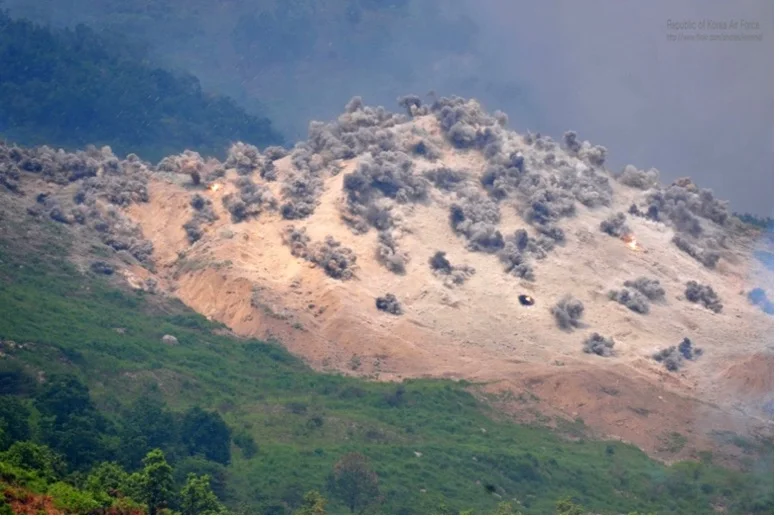 A cluster munition strike. Photo:Wikimedia
A cluster munition strike. Photo:Wikimedia
The DPICM could be used in a “rolling wave” of interlocking strikes, starting at the front edge of the minefield moving forward clearing a wide breaching lane and then moving on to the enemy’s defensive positions to provide suppressive fire as the Ukrainian attacking force moved forward onto the enemy’s defensive positions.
In this way the impasse that the Armed Forces of Ukraine (AFU) currently faces on the front-line could be overcome.
It may not work but surely it’s worth a try?
You can also highlight the text and press Ctrl + Enter


